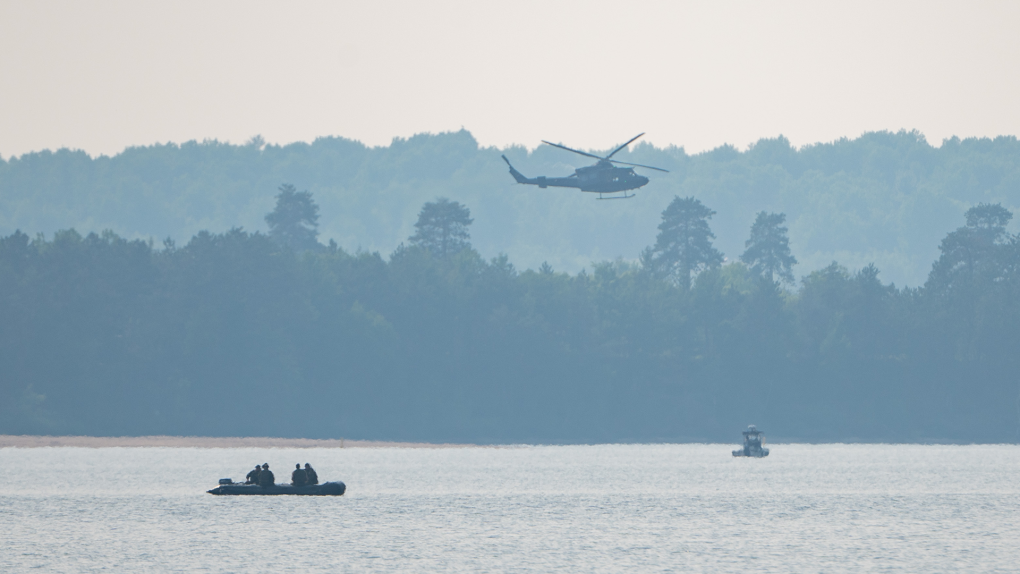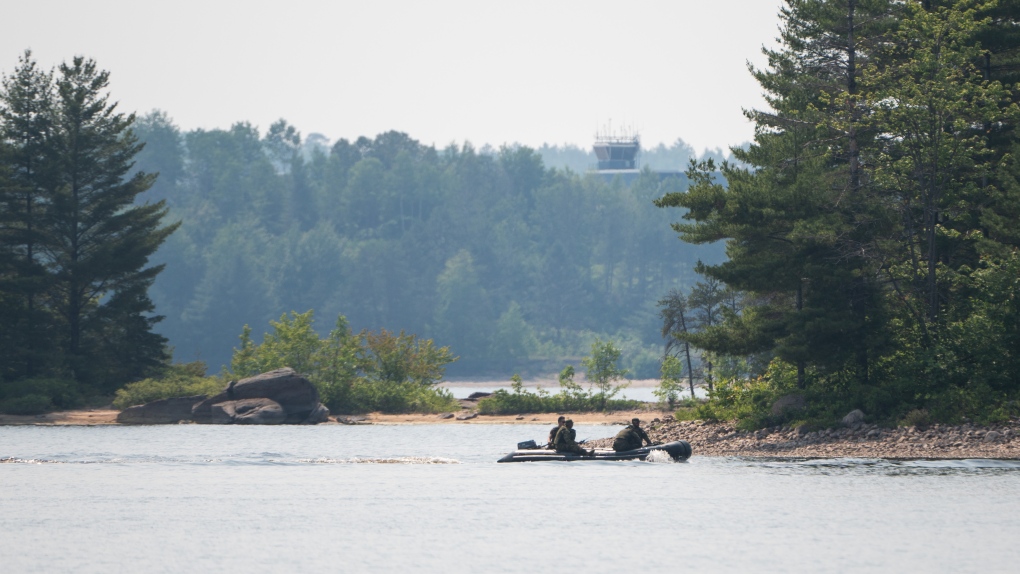Multiple elements contributed to fatal Chinook helicopter crash in Ottawa River, investigation concludes
 Capt. David Domagala and Capt. Marc Larouche died when the CH-147F Chinook helicopter crashed near Garrison Petawawa on June 20, 2023. (Cpl. Lindsay Jellicoe/Department of National Defence)
Capt. David Domagala and Capt. Marc Larouche died when the CH-147F Chinook helicopter crashed near Garrison Petawawa on June 20, 2023. (Cpl. Lindsay Jellicoe/Department of National Defence)
The investigation into a Chinook helicopter crash near Petawawa, Ont. that killed two military pilots concludes an "unperceived acceleration" and environmental conditions were "significant contributors" to the crash in the Ottawa River.
Capt. David Domagala and Capt. Marc Larouche died when the CH-147F Chinook helicopter crashed near Garrison Petawawa on June 20, 2023. Two flight engineers were able to escape the crash with minor injuries.
 A Royal Canadian Air Force (RCAF) helicopter and Canadian Armed Forces (CAF) boat search the Ottawa River near Fort William in Pontiac Regional County Municipality, Que. on Tuesday, June 20, 2023. THE CANADIAN PRESS/Spencer Colby
A Royal Canadian Air Force (RCAF) helicopter and Canadian Armed Forces (CAF) boat search the Ottawa River near Fort William in Pontiac Regional County Municipality, Que. on Tuesday, June 20, 2023. THE CANADIAN PRESS/Spencer Colby
The helicopter, known by its call-sign Hammer 31, was conducting a nighttime training flight over the Ottawa River at the time of the crash.
On Monday, the Royal Canadian Air Force's Directorate of Flight Safety announced the conclusion of its investigation.
"The Flight Safety Investigation determined that as the crew initiated a turning manoeuvre over the river, the aircraft entered a constant but imperceptible descent," the RCAF said in a statement.
"None of the crew realized the aircraft's altitude and/or rate of descent until impact, resulting in a Controlled Flight into Terrain accident. It concluded that unrecognized downward acceleration, along with environmental conditions that night, were significant contributors to the accident, causing spatial disorientation among the crew."
The Department of National Defence had previously said the helicopter started to descend during the training exercise and was turning left when it struck the Ottawa River "with high energy." The investigation was said to be focusing on human, technical and environmental factors.
"This accident was not caused by a single factor, instead, multiple elements contributed to the unrecognized spatial disorientation of all crew members of Hammer 31, leading to the continued descent until water impact," Col. Jean-Francois Gauvin, Director of Flight Safety, said in a statement.
"Over 16 months, we thoroughly analyzed a large amount of data and collaborated closely with partners to identify additional contributing factors. Several recommendations are provided to help prevent similar accidents in the future.”
The report makes several recommendations to amend the CH-147F publications, including a recommendation to mandate the use of automation Level-3 (Native Mode Digital Automatic Flight Control System) when operating below 200 feet above water at night. The report also makes recommendations to improve emergency response preparedness.
 Canadian Armed Forces (CAF) conduct searches around a series of islands on the Ottawa River near Fort William in the Pontiac Regional County Municipality on Tuesday, June 20, 2023. Two RCAF 450 Tactical Helicopter Squadron members were missing following a CH-147F Chinook early morning crash near Garrison Petawawa. (Spencer Colby/THE CANADIAN PRESS)
Canadian Armed Forces (CAF) conduct searches around a series of islands on the Ottawa River near Fort William in the Pontiac Regional County Municipality on Tuesday, June 20, 2023. Two RCAF 450 Tactical Helicopter Squadron members were missing following a CH-147F Chinook early morning crash near Garrison Petawawa. (Spencer Colby/THE CANADIAN PRESS)
Officials say, "preventative measures" are recommended at the base, squadron, wing, division and strategy levels to "enhance safety and mitigate the risks associated with over-water missions."
The Royal Canadian Air Force has a fleet of 14 CH-147F Chinooks, with the current fleet acquired starting in 2013.
The next-of-kin of the fallen pilots were briefed on the conclusions of the flight safety investigation report before it was released, according to the Department of National Defence.
CTVNews.ca Top Stories

Calgary woman stranded in Mexico after husband's death during diving trip
A Calgary woman is struggling to return home after her husband died while diving in Mexico, leaving her stranded and facing financial hardship.
Fugitive U.S. rioter seeks asylum in Whistler amid warnings of more to come
An American citizen convicted of participating in the Jan. 6, 2021, riot on Capitol Hill and dodging jail time in Whistler may just be the start of an asylum-seeking rush, according to a prominent legal expert.
Soldier who died by suicide in Las Vegas told ex-girlfriend of pain and exhaustion after Afghanistan
The highly decorated Special Forces soldier who died by suicide in a Cybertruck explosion on New Year's Day confided to a former girlfriend who had served as an Army nurse that he faced significant pain and exhaustion that she says were key symptoms of traumatic brain injury.
'Support better care': Advocates argue need for mental health emergency service
The crisis service sees two mental health clinicians respond to well-being checks without police. Calls are received through 211 or 911, and workers are dispatched if there aren't immediate public safety or medical concerns.
Man arrested after committing five bank robberies in 10 days: Toronto police
A man accused of robbing five Toronto-area banks in a 10-day period has been arrested by Toronto police.
Special national Liberal caucus meeting called for next week after regional chairs meet: sources
A special meeting of Prime Minister Justin Trudeau's national Liberal caucus has been called for next Wednesday, sources say.
N.S. community shocked by deaths of father, daughter; suspect was wanted in Toronto shooting
A Nova Scotia community is mourning the loss of two of its members after they were shot and killed in Halifax on New Year's Eve.
'Inadmissible' foreign nationals to pay more upon return to Canada: CBSA
Foreign nationals who refuse or are unable to pay their own way home after being denied stay in Canada will soon face steeper financial penalties should they ever attempt to return.
Canada pausing applications for parent, grandparent permanent residency sponsorships
Canada will not accept new parent and grandparent permanent residency sponsorship applications until further notice, according to a ministerial directive.


































